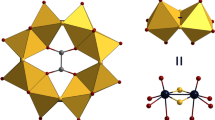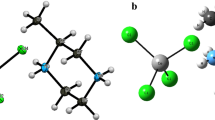Abstract
Since the 1960s, dithiolene complexes have been intensely studied; however, the same cannot be said about diselenolene complexes. Thus, the chemistry associated with the reduction of several Mo- and W-tris(diselenolene) complexes was investigated. In particular, relative reduction potentials, changes in key geometrical properties, the contribution of the metal center to the redox active MO, and HOMO–LUMO energy gaps are investigated. It is noted that the results obtained for the tris(diselenolene) complexes are compared to analogous Mo- and W-tris(dithiolene) complexes to understand the effect of substituting the sulfur atoms with selenium atoms. The reduction potentials of the complexes are more dependent upon the choice of the ligand than the metal. Overall, it is found that the substitution of chalcogen atom for the tris complexes investigated herein has only a subtle effect on the calculated reduction potentials between analogous redox couples. Upon reduction of the neutral and mono-anionic complexes, it is found that changes in key bond lengths, fold angles (θ), and trigonal twist angles (ΦAvg) are very similar for the tris(diselenolene) complexes investigated. Such changes have been previously observed for several Mo- and W-tris(dithiolene) complexes. Comparing the HOMO–LUMO energy gaps of the tris(diselenolene) complexes to the tris(dithiolene) complexes, the former complexes have on average a 0.07-eV smaller energy gap and are thus expected to be slightly more reactive to reduction. Lastly, in the neutral complexes, the Mo and W atoms contribute at most 26% to the redox active MO; thus, in the case of the tris(diselenolene) complexes, it can be concluded that the redox active MO is predominantly ligand based. The contribution of the metal-based AO becomes less as the complexes are reduced. In summary, given the high interest of dithiolene complexes in the areas of alternative energy and material science, the results presented herein provide motivation to further investigate the chemistry of diselenolene complexes.


Similar content being viewed by others
References
Stiefel EI (2004) In: Karlin KD, Stiefel EI (eds) Dithiolene chemistry, vol 52 . John Wiley & Sons, Inc., Hoboken, New Jersey, pp. vii–vixch. Preface
Eisenberg R (1970) Prog Inorg Chem 12:295
Beswick CL, Schulman JM, Stiefel EI (2004) In: Karlin KD, Stiefel EI (eds) Dithiolene chemistry, vol 52. John Wiley & Sons, Inc., Hoboken, New Jersey, pp. 55–110
Eisenberg R and Ibers JA (1966) Inorg. Chem
Eisenberg R and Ibers JA (1965) J. Am. Chem. Soc. 87
Smith AE, Schrauzer GN, Mayweg VP, Heinrich W (1965) J Am Chem Soc:87
Pierpont CG, Eisenberg R (1971) J Chem Soc A. doi:10.1039/j19710002285, 2285-2289
Bushnell EAC, Boyd RJ (2015) J Phys Chem A 119:911–918
Eisenberg R, Gray HB (2011) Inorg Chem 50:9741–9751
Ørnsø KB, Jónsson EÖ, Jacobsen KW, Thygesen KS (2015) J Phys Chem C 119:12792–12800
Bushnell EAC, Boyd RJ (2016) Int J Quantum Chem 116:369–376
Frisch MJ, Trucks GW, Schlegel HB, Scuseria GE, Robb MA, Cheeseman JR, Scalmani G, Barone V, Mennucci B, Petersson GA, Nakatsuji H, Caricato M, Li X, Hratchian HP, Izmaylov AF, Bloino J, Zheng G, Sonnenberg JL, Hada M, Ehara M, Toyota K, Fukuda R, Hasegawa J, Ishida M, Nakajima T, Honda Y, Kitao O, Nakai H, Vreven T, Montgomery JA Jr., Peralta JE, Ogliaro F, Bearpark M, Heyd JJ, Brothers E, Kudin KN, Staroverov VN, Keith T, Kobayashi R, Normand J, Raghavachar K, Rendell A, Burant JC, Iyengar SS, Tomasi J, Cossi M, Rega N, Millam JM, Klene M, Knox JE, Cross JB, Bakken V, Adamo C, Jaramillo J, Gomperts R, Stratmann RE, Yazyev O, Austin AJ, Cammi R, Pomelli C, Ochterski JW, Martin RL, Morokuma K, Zakrzewski VG, Voth GA, Salvador P, Dannenberg JJ, Dapprich S, Daniels AD, Farkas O, Foresman JB, Ortiz JV, Cioslowski J and Fox DJ, Gaussian, Inc., Wallingford CT (2010)
Zhao Y, Truhlar DG (2008) Theor Chem Accounts 120:215–241
Zhao Y, Truhlar DG (2008) Acc Chem Res 41:157–167
Ehlers AW, Bohme M, Dapprich S, Gobbi A, Hollwarth A, Jonas V, Kohler KF, Stegmann R, Veldkamp A, Frenking G (1993) Chem Phys Lett 208:111–114
Hay PJ, Wadt WR (1985) J Chem Phys 82:299–310
Roy LE, Hay PJ, Martin RL (2008) J Chem Theory Comput 4:1029–1031
Curtiss LA, McGrath MP, Blaudeau JP, Davis NE, Binning RC, Radom L (1995) J Chem Phys 103:6104–6113
Krishnan R, Binkley JS, Seeger R, Pople JA (1980) J Chem Phys 72:650
McLean AD, Chandler GS (1980) J Chem Phys 72:5639
Hu L, Chen H (2015) J Chem Theory Comput 11:4601–4614
Llano J, Eriksson LA (2002) J Chem Phys 117:10193–10206
Roy LE, Jakubikova E, Guthrie MG, Batista ER (2009) J Phys Chem A 113:6745–6750
Gritzner G, Kuta J (1984) Pure Appl Chem 56:461–466
Namazian M, Lin CY, Coote ML (2010) J Chem Theory Comput 6:2721–2725
Pavlishchuk VV, Addison AW (2000) Inorg Chim Acta 298:97–102
Wang K (2004) In: Karlin KD, Stiefel EI (eds) Dithiolene chemistry, vol 52. John Wiley & Sons, Inc., Hoboken, New Jersey, pp. 267–314
Kirk ML, McNaughton RL, Helton ME (2004) In: Stiefel EI (ed) Progress in inorganic chemistry: synthesis, properties, and applications, vol 52. John Wiley & Sons Inc, New York, pp. 111–212
Stiefel EI and Brown GF (1972) Inorg. Chem. 11
Cowie M, Bennett MJ (1976) Inorg Chem 15:1584–1589
Ryde U, Schulzke C, Starke K (2009) J Biol Inorg Chem 14:1053–1064
Aihara J (1999) J Phys Chem A 103:7487–7495
Ray K, George SD, Solomon EI, Wieghardt K, Neese F (2007) Chem-Eur J 13:2783–2797
Baerends TZEJ, Autschbach J, Bashford D, Bérces A, Bickelhaupt FM, Bo C, Boerrigter PM, Cavallo L, Chong DP, Deng L, Dickson RM, Ellis DE, van Faassen M, Fan L, Fischer TH, Fonseca Guerra C, Franchini M, Ghysels A, Giammona A, van Gisbergen SJA, Götz AW, Groeneveld JA, Gritsenko OV, Grüning M, Gusarov S, Harris FE, van den Hoek P, Jacob CR, Jacobsen H, Jensen L, Kaminski JW, van Kessel G, Kootstra F, Kovalenko A, Krykunov MV, van Lenthe E, McCormack DA, Michalak A, Mitoraj M, Morton SM, Neugebauer J, Nicu VP, Noodleman L, Osinga VP, Patchkovskii S, Pavanello M, Philipsen PHT, Post D, Pye CC, Ravenek W, Rodríguez JI, Ros P, Schipper PRT, Schreckenbach G, Seldenthuis JS, Seth M, Snijders JG, Solà M, Swart M, Swerhone D, te Velde G, Vernooijs P, Versluis L, Visscher L, Visser O, Wang F, Wesolowski TA, van Wezenbeek EM, Wiesenekker G, Wolff SK, Woo TK, Yakovlev AL, SCM, Theoretical Chemistry, Vrije Universiteit, Amsterdam, The Netherlands, ADF2013 edn
van Lenthe E, Ehlers A, Baerends EJ (1999) J Chem Phys 110:8943–8953
van Lenthe E, Baerends EJ, Snijders JG (1993) J Chem Phys 99:4597–4610
van Lenthe E, Baerends EJ, Snijders JG (1994) J Chem Phys 101:9783–9792
Acknowledgements
EACB thanks the Natural Sciences and Engineering Research Council of Canada (NSERC) for funding. In addition, RJB thanks the NSERC for funding. Computational facilities are provided by ACEnet, the regional high-performance computing consortium for universities in Atlantic Canada. ACEnet is funded by the Canada Foundation for Innovation (CFI); the Atlantic Canada Opportunities Agency (ACOA); and the provinces of Newfoundland and Labrador, Nova Scotia, and New Brunswick. We also thank SHARCNET and Compute Canada for the additional computational resources.
Author information
Authors and Affiliations
Corresponding author
Electronic supplementary material
ESM 1
The values of r(M–X), r(C–X) and r(C–C) (X = S and Se; M = Mo and W) for each of the complexes investigated herein are provided in Tables S1 and S2. The calculated average values of the fold angle (θ) and twist angle (Φ) for the tris(dithiolene)/diselenolene complexes are provided in Tables S3 and S4. The HOMO–LUMO energy gaps for [M(L)3]z and [M(L’)3]z (z = 0, 1–, 2–; M = Mo and W) are provided in Table S5. (DOCX 79 kb)
Rights and permissions
About this article
Cite this article
Bushnell, E.A.C., Adams, M.R. & Boyd, R.J. A computational investigation into the redox chemistry of Mo- and W-tris(diselenolene) complexes. Struct Chem 28, 1173–1180 (2017). https://doi.org/10.1007/s11224-017-0926-y
Received:
Accepted:
Published:
Issue Date:
DOI: https://doi.org/10.1007/s11224-017-0926-y




